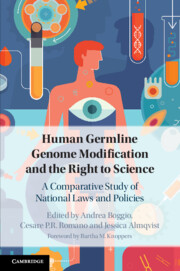 Human Germline Genome Modification and the Right to Science
Human Germline Genome Modification and the Right to Science from Part IV - Other OECD Countries
Published online by Cambridge University Press: 15 November 2019
Australia was at the cutting edge in the development of Artificial Reproductive Technology in the 1960s and 1970s. Regulatory responses were piecemeal: only a small number of the six states and two territories enacted legislation. The regulatory response to reproductive cloning and embryonic stem cell research has been more uniform, with nationally consistent legislation in the form of the Prohibition of Human Cloning for Reproduction Act 2002 and the Research Involving Human Embryos Act 2002, together with the Gene Technology Act 2000. This regulatory regime creates a prohibitory environment for germline genome therapy in Australia and provides little scope for genome editing research involving human embryos, even under licence. This chapter discusses the Australian regulatory regime, with particular focus on this triad of legislative instruments. Although Australia has made a commitment to science and health, and recognition of the right to found a family, the special status of the embryo is a paramount consideration. This chapter concludes that, as in many other countries, Australia is at a crossroads, and Australians must decide, collectively, how far genome editing research involving human embryos should be allowed to progress.
To save this book to your Kindle, first ensure no-reply@cambridge.org is added to your Approved Personal Document E-mail List under your Personal Document Settings on the Manage Your Content and Devices page of your Amazon account. Then enter the ‘name’ part of your Kindle email address below. Find out more about saving to your Kindle.
Note you can select to save to either the @free.kindle.com or @kindle.com variations. ‘@free.kindle.com’ emails are free but can only be saved to your device when it is connected to wi-fi. ‘@kindle.com’ emails can be delivered even when you are not connected to wi-fi, but note that service fees apply.
Find out more about the Kindle Personal Document Service.
To save content items to your account, please confirm that you agree to abide by our usage policies. If this is the first time you use this feature, you will be asked to authorise Cambridge Core to connect with your account. Find out more about saving content to Dropbox.
To save content items to your account, please confirm that you agree to abide by our usage policies. If this is the first time you use this feature, you will be asked to authorise Cambridge Core to connect with your account. Find out more about saving content to Google Drive.